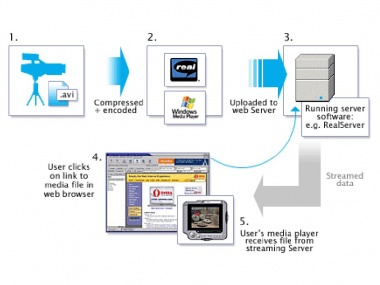Streaming Media Technology
From Computing and Software Wiki
Streaming media is multimedia that is constantly received by, and normally displayed to, the end-user while it is being delivered by the provider.[1] Streaming media technolgy enables on-demand or real-time access to multimedia content via internet and allows users to play those contents without fully downloading them. After playing, there's no copy of played contents leaving on the receiving devices, which protects the copyright of the original mutimedia contents.
Contents |
Introduction
When the user requests to play a media object that is stored on a remote server, the data blocks are retrieved from the remote server over a network, and passes to the client for display.[3] There are ususaly two ways of doing that. First, the player doesn't play until the media object is completely downloaded on the client. Second, the player can start to play while "streaming" the media as long as enough data has been received - without waiting for the fully downloading, which is so-called the streaming media.
Compared with the way of fully downloading, the way of streaming takes many advantages. First, there's almost no waiting time for downloading. Second, no copies are stored during the process, which protects the copyright and reduces the storage requirement of the client. Third, real-time events becomes possible. However, streaming is always limited by the network conditions. If the speed of the network is very slow, the way of streaming won't work well and some data may lost during the transport process.
System Architecture
Assume a streaming media object S that contains n equal size blocks: S0, S1, ..., Sn-1, and is stored on a streaming media server. There are three important time variable needed to mention:
- The display time of each block is a function of the display requirments of each object and the size of the block. For example, if the display requirement of the object S is 3 Mb/s and the size of each block, Si, is 3 Mbytes, then the display time of each block is 8 seconds. [3]
- The retrieval time of each block is a function of the transfer rate of the server. [3]
- The delivery time of each block from the server to the client is a function of the network speed, traffic, and protocol used. [3]
P.S.: The architecture described here is completely learned from the book Streaming Media Server Design, which is listed as reference [3].
Storage and Bandwidth
To be filled
Data Compression
Run-length encoding
Relative encoding
Huffman encoding
Transform encoding
To be filled
Network Protocols
RTP
RTCP
RTSP
RSVP
To be filled
Applications
- A
- B
- C
- D
References
[1] Wikipedia, "Streaming Media", April 2008, "http://en.wikipedia.org/wiki/Streaming_media" .
[2] Sequence website, "http://www.sequence.co.uk/services/streamingmedia/howdoesitwork.html" .
[3] Dashti, Ali E. Streaming Media Server Design, Prentice Hall, 2003
See also
External links
- streamingmedia.com - Streaming Media Industry News
- Streaming Media - Streaming Media Wiki Page
- TCP/IP_model - Protocols on the Five-layer TCP/IP Model
--Chuh 15:58, 7 April 2008 (EDT)

